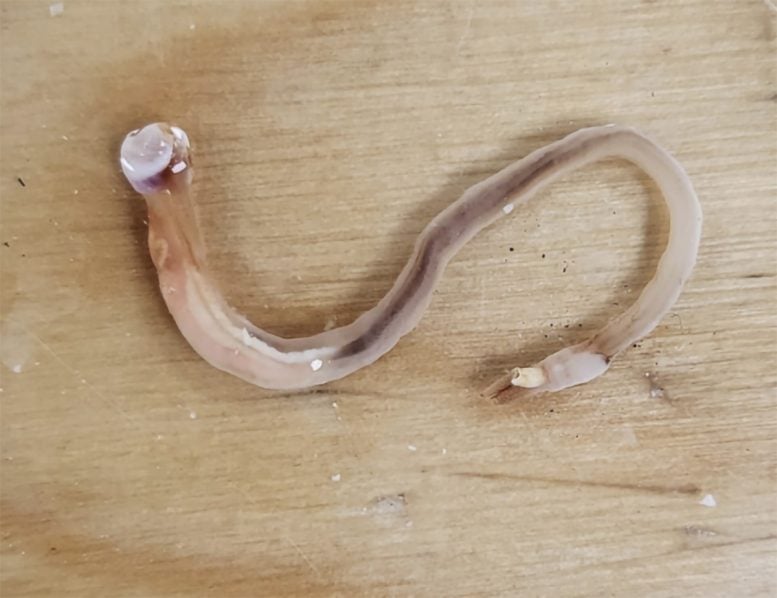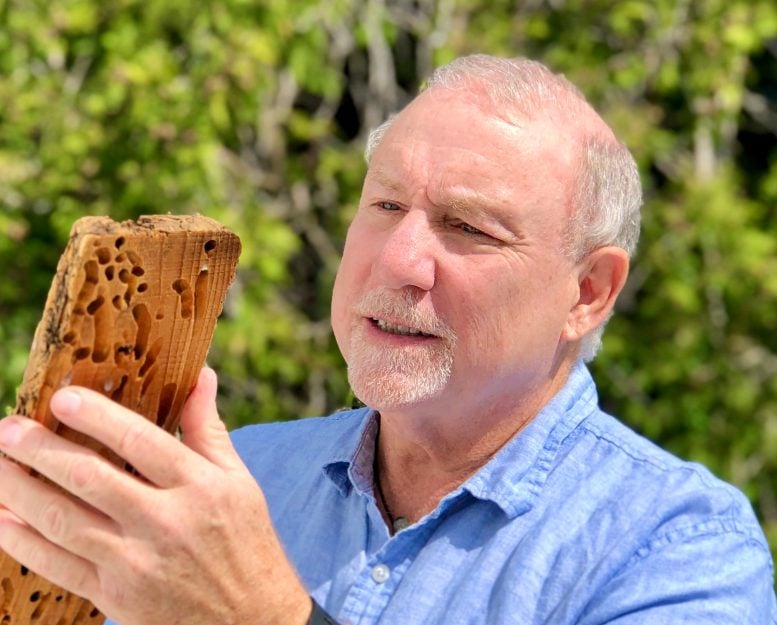New research has revealed that shipworms digest wood using symbiotic microbes in their guts, a discovery that overturns previous understanding and has significant implications for biotechnology and environmental modeling. A cross-section of a Belfast dock riddled with wormholes. Credit: Barry Goodell
Uncovering the secrets of the world’s most fascinating and destructive mollusk could affect everything from climate change to public health.
They damaged ancient Greek navies, helped shipwreck Christopher Columbus, helped sink the Spanish Armada, and caused wharves in San Francisco Bay to collapse into the sea, but until now scientists have been unable to pinpoint exactly how the worms—a family of molluscs—are able to cause such damage. A team of researchers, jointly led by the University of Massachusetts Amherst and the University of Plymouth, along with collaborators from the University of Maine and UMass Chan Medical School, discovered that a population of symbiotic microbes living in an overlooked sub-organ of the gut called the “typhosol” has the ability to secrete enzymes needed for digestion lignin – the hardest part of wood.
“Shipworms are such important animals,” says Reuben Shipway, co-author of research published recently in International biodeterioration and biodegradation and who initiated this work as part of his postdoctoral residency at UMass Amherst. “They are found in the world’s oceans and not only have they changed history, they are also ecosystem engineers and play a vital role in the carbon cycle in the aquatic environment. It’s unbelievable that we haven’t quite figured out how they do it.’
Digestion of wood by shipworms
Wood is a wonder substance: flexible and tough, its fibrous but nutritious cellulose can make great food—but only for those living things that can digest it and also get through the layer of lignin, the tough, armor-like substance that surrounds the cellulose as a coating on your favorite rage-inducing treat. Microbiologists have long known that animals capable of digesting lignin—like termites—host specialized, symbiotic colonies of microbes in their guts that do the work of breaking down lignin for them. “But,” says lead author Barry Goodell, a recently retired professor of microbiology at UMass Amherst and professor emeritus at the University of Maine, “the shipworm’s digestive tract has long been considered virtually sterile.”

A shipworm is actually a mollusk found in the world’s oceans. Credit: Reuben Shipway
So how do shipworms do what they do?
Goodell and Shipway have spent the better part of the last decade trying to answer that question, testing a number of innovative hypotheses—none of which have given up the mystery of shipworms.
“We decided to take a very close look at the guts of the shipworm again,” says Goodell, “on the occasion that researchers had missed something over the last hundred years.”
This seems to be the case indeed.
It turns out that shipworms have a special suborgan called a typhlosole — “it looks like an upside-down Salvador Dali mustache,” says Shipway — that’s housed in the mollusk’s digestive tract. Previous researchers had thought it served as a mixing structure, but when Goodell and Shipway did some precision cultivation, they used Argonne National Laboratory’s facilities for metagenomic analysis as well as the lab’s advanced genetic probe and microscopy techniques. The UMass Amherst Institute for Applied Life Sciences discovered what generations of researchers had overlooked: hidden clusters of bacterial symbionts with the ability to produce lignin-splitting enzymes.

Barry Goodell (UMass Amherst) examines wood riddled with worm holes. Credit: Barry Goodell
Potential applications and environmental impact
Not only does this research help solve a long-standing mystery, but the findings may also have important practical applications. Biotech companies are looking for new enzymes that can digest resistant substrates more efficiently than current bioindustrial processes allow, and new sources of enzymes that can unlock the structure of biomass residues are critical to growing this field. In addition, previous shipworm symbionts have been shown to be a treasure trove of natural products – such as new anti-parasitic antibiotics – that may have a significant impact on human health.
When it comes to climate change, research like this can help improve models predicting how CO2 and other greenhouse gases are released into the environment, especially as large amounts of woody debris on land winds up in the ocean, where much of it passes through the gut of a shipworm.
Finally another animal species, including other molluscs, earthworms, and even the tadpole stage of frogs, also have typhlosol, which has not been thoroughly investigated before. If symbionts similar to those found in shipworms are found in these animals, it could change our understanding of how these animals also make their way around the world. “It’s very satisfying,” Goodell says of the research. “We’ve been trying to solve this mystery for years, and we finally discovered the hidden secret of the shipworm’s bacterial symbiont.”
Reference: “First report of microbial symbionts in the digestive system of shipworms; wood boring mollusks” by Barry Goodell, James Chambers, Doyle V. Ward, Cecelia Murphy, Eileen Black, Luccy Bonjy Kikuti Mancilio, Gabriel Perez-Gonzalez, and J. Reuben Shipway, 5 June 2024, International biodeterioration and biodegradation.
DOI: 10.1016/j.ibiod.2024.105816